TVNI, as a knowledge based organization, has a primary goal of promoting the Vetiver System (VS) across several economic and natural resource sectors. It is possible to do this because of the unique character of Vetiver grass (Chrysopogon zizanioides) that provides the basis for a wide range of applications, most of which significantly impact soil and water. The plant has deep penetrating roots that improve the soil shear strength by as much as 40+% and the ability within the rhizosphere to capture and cycle soil nutrients critical to plant growth. The same roots working with soil mycorrhiza can capture toxic chemicals and heavy metals without damage to the plant. A mature plant’s very large biomass (in the order of +/- 2 kg per plant) can provide multiple uses and benefits and can sequester large amounts of atmospheric carbon dioxide that can be stored in its massive root system. See Paul Truong’s publication for a full review of the function of vetiver grass “Vetiver Grass the Hidden Half”. The benefits of each individual plant, when planted as a “Stiff Grass Hedge”, can be further multiplied through different plant design configurations.
Many people, including users of vetiver, do not fully understand how a vetiver hedgerow functions, and how the hedgerow and the plant itself can accelerate the restoration of soil health and water balances, particularly in the tropics.
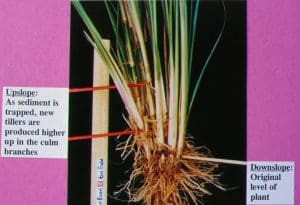
The function and importance of Stiff Grass Hedges “Narrow stiff grass barriers (hedgerows) when placed across the slope of the land, if applied correctly, create the means of reducing sheet, rill, and ephemeral gully erosion by trapping sediment and spreading the concentrated flow of high velocity rainfall runoff (Dabney 1996). Stiff Grass Hedges (SGH) such as vetiver can do this because they can withstand high flows (40mm deep) and velocities (as much as 0.04 m-3sec-1m-1) and can continue to perform with the buildup of sediment behind the hedge, whereas shorter and softer vegetation will fail and become inundated. Over time the sediment buildup behind the hedgerows changes the slope of the upslope land further reducing flow velocity and increasing the spreading and back ponding effect. Meyer (1995), using a flume study of Vetiver and Switch grass (Panicum virgatum), concluded that SGH have great potential for retarding concentrated overland flows, retarding runoff, and trapping sediment … grasses like vetiver that can retard both low and high (40 cm) flows are thus the most effective….”
“Kervroëdan (2018) investigated composition of narrow vegetative barriers (hedges) for sediment control in France concluded that SGH efficiency depended on hydraulic roughness reflected by stem and tiller density, stem stiffness, and leaf density. Vetiver was not part of the evaluation, but has all the positive traits that makes a good SGH, having dense tillers and stems that work with low flows, and leaves and stem that are stiff and dense that provide the necessary hydraulic roughness at high flows…”
Tables 1 and Figures 1 and 2 demonstrate the superiority of vetiver over other stiff grasses in its density and compactness. Photos 2 and 3 show well-formed 3 year old hedgerows – a “living wall”.
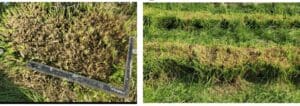
Table 1. A comparison of stem count and area occupied by stems for vetiver and two species of Miscanthus — a clump grass under testing by the US Soil Conservation Service as a cold climate substitute for vetiver. Sampling consisted of measurements taken on two plants of each species; all plants were the same age. Note because vetiver stem diameter is significantly larger than that of the other grasses the vetiver covered a greater area at greater density.
| Stiff Grass Name | Total Stem Count | Sample Average | Stem Total Compared to Vetiver | Compared to Vetiver % | Total Area mm2 | Total Area Compared to Vetiver mm2 | Total Area Compared to Vetiver % |
|---|---|---|---|---|---|---|---|
| Vetiver | 589 | 294.5 | 10066 | ||||
| M. sinensis | 629 | 314.5 | 20 | + 6.8 | 5606 | -4460 | -44.3 |
| M. zebrinus | 1455 | 413 | 118.5 | + 40 | 7057 | -3010 | -29.9 |
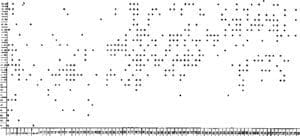
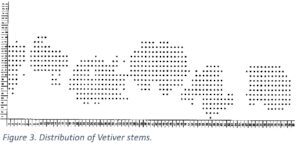
“The other important primary function of the SGH is to increase the infiltration rate of rainwater. Studies indicate that there is a significant increase in infiltration due to large, dense, and deep roots, and large soil pores with respect to SGH grasses, Dabney (1996). This increased infiltration results in reduced runoff. A study by Rachman (2004) indicated that hydraulic conductivity within the hedgerow (130 mm h1) was 7 times more than in comparative row crops maize (18 mm h1), and 24 times more than in the fully saturated adjacent sediment deposition area (5.4 mm h1) immediately up-slope of the hedge”. In effect a vetiver hedge acts as a very safe vertical drain, directing part of the flow for groundwater recharge, and the balance spread evenly through the hedge to”irrigate” down-slope land.
If these two basic functions are understood, then the need for fully formed and dense hedgerows as shown in photo 4, and as discussed in the November newsletter, becomes more apparent, and is an essential component of most quality Vetiver System applications.
The ability of SGH acting as a major instrument for protection against increasingly frequent and intense rainfall events, in our case vetiver, to delay and spread high velocity rainfall runoff flows ; to improve the rate of rainwater infiltration; and to trap eroding soil (and the contaminants that are attached to the soil particles) makes vetiver (along with all its other attributes) a good choice to help correct watershed hydrological imbalances that are currently affecting the Global Hydrological Cycle. The resulting improvement in soil moisture is an important necessity for the improvement of soil microbial activity, soil health generally, and crop production.
A cursory look at Google Earth imagery shows that many farmers continue to cultivate up and down or obliquely across slopes. We need to renew efforts to cultivate on the contour, a practice that can reduce rainfall runoff by +/- 30%. These farmers rarely have protective conservation measures to against extreme weather events. And where they do, the measures are often poorly designed or badly maintained, and cannot perform effectively under extreme events.
There is much research comparing the efficiency of constructed terraces (bunding) and vetiver hedgerows for erosion control – results differ as to which performs best, but in most cases STIFF GRASS HEDGES give superior results. Few of the research studies include economic analysis. Vetiver hedgerows cost 3 to 5 times less to establish and maintain than constructed terraces. It would seem a no-brainer as to which technology one should use, and there is no question that the total benefits from SGH far outweigh those of an inert earth structure.
Research data and practice from Thailand and Ethiopia indicate that where vetiver is planted on existing constructed earth bunds (normally outward sloping) and terrace risers, infiltration rates and sediment reduction losses are always better compared to the bund/terrace with no vetiver. Consideration should be given, throughout the tropics and semi arid countries, to the retrofitting, using stiff grass vetiver hedgerows, of tens of thousands of miles of old bunds and terraces (most of which are outward sloping, not maintained and not working as designed). Retrofitting would be easy, and would in addition deliver other benefits of vetiver hedgerows that include higher crop yields at lower cost, pest control; biomass for mulch, forage, biofuel, removal of unwanted chemicals, thatch; windbreaks, carbon sequestration and other benefits.
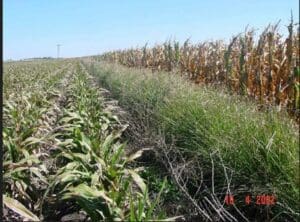
The hydrological attributes mentioned above also suggest that VGT should be applied as a management and conservation practice in lowland areas where the topography is quite flat (contrary to the general practice of promoting sloping land conservation only). Vetiver, if correctly applied and maintained, could provide multiple benefits to lowland farmers on near flat land, especially for improving infiltration rates, removal of excess phosphates, nitrates, and other chemicals, mulching, control of some pests and other uses. Rice farmers (flat land) in China have found that using vetiver for the control of pink and striped stem borer has resulted in significant reductions in pesticide applications, and the return of the much prized paddy field frog at no loss of yield, but an increase in income.
Upscaling VGT.
Communities and their advisors, with a better understanding of the function of a SGH, should find it easier to discuss and execute upscaling programs. Upscaling requires a serious and coordinated effort to develop policies, incentives, and other support involving central and local (county) administrations. Although a lot can be done through social media and promotional events, there is a need for some serious administrative backing to provide guidelines, critical training of trainers, workshops, etc. Often the process of upscaling starts, in the absence of government action, through individual activism/demonstration and NGO involvement. In some instances, local government staff have never even heard of VGT. Inviting them to farmer field days to see VGT in action often has a positive result, particularly if there is community involvement.
To make a measurable impact on the “Global Hydrological Cycle” and soil health, farming communities need to take necessary steps to improve the watershed or sub watershed in which they are located. A few isolated actions may benefit a few individuals, but may have little impact on the overall watershed, and will not effect the increase of overall storm runoff and downstream flooding. Multiple actions by multiple people are necessary. Such action needs a watershed plan, one that is planned and executed by the community using where possible their own resources. To help communities plan their priorities and proposed activities, their members need a better understanding, at a landscape level, of amongst others: their locality, their community’s natural resources and related infrastructure inventory, their relationship with other community members, and the locality of priority problem areas that need addressing. Detailed maps can help do this. as well providing a means of estimating their costs both for individual and community labor and financing.
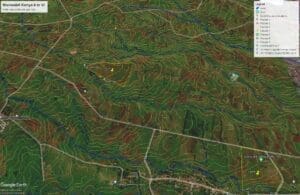
These maps need to show contours so that landforms can be better understood and activities including those relating to VGT can be better planned. The maps can be created through free software such as Google Earth and QGIS. Most people with a minimum of computer knowledge could quite easily learn how to use these tools for watershed planning and execution at community level. Two guides have been developed that can be downloaded and used for this purpose.
- How to use Google Earth Pro to support the planning and monitoring of farm, watershed, and landscape improvements in relation to vetiver grass technology.
- How to create a contour line overlay layer for Google Earth Pro.
A third guide “Contour farming and soil and water conservation — A modified sight leveling device and how to survey contour vetiver hedgerows” has been prepared with the purpose of introducing community contour surveyors (including farmers) to an improved low cost and simple device for surveying and marking level (on the contour) vetiver hedgerows for conservation and marker line purposes.
Richard Grimshaw (December 2023)
Excellent note